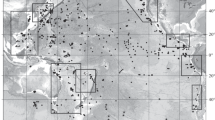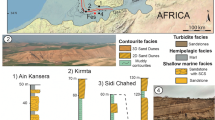Abstract
Through the analysis of ocean organisms, the distribution characteristics and enrichment of organic matters in modern marine sediments and ancient marine strata, this paper shows that the main factors influencing the formation of excellent marine source rocks are the paleoclimate, biologic productivity, terrestrial organic matter, oxidation–reduction environment, sedimentation rate, and the type of the basin. In addition to those factors, high biologic productivity or high content of terrestrial organic matter input is a requirement for the enrichment of the organic matter in a marine environment. Reducing environment was favorable for organic matter accumulation and preservation in depositing and early diagenesis stage, which is an important element for the formation of high-quality marine source rocks. Paleoclimate also influences the marine source rocks formation, as humid subtropical and tropical climates are the most favorable regimes for the formation of marine source rocks. Wind transports some vascular plant materials into the marine environment. Furthermore, upwellings driven by steady wind can cause high biologic productivity, thus forming organic-C-rich mud. Suitable sedimentation rate is beneficial for marine organic matter accumulation. Moreover, the type of the basin also plays an important role in the development of marine source rocks. Silled basins with a positive water balance often act as nutrient traps, thus enhancing both productivity and organic matter preservations, while in open oceans, organic matter enrichment in sediments has just been found in the oxygen minimum layers.







Similar content being viewed by others
References
Burnett WC, Roe KK, Piper DZ (1983) Upwelling and phosphorite formation in the ocean. In: Suess E, Thiede J (eds) Coastal upwelling: its sediment record, Part A. Plenum Press, New York, pp 377–397
Calvert SE (1987) Oceangraphic controls on the accumulation of organic matter in marine sediments. In: Brook J, Fleet AJ (eds) Marine petroleum source rock. Blackwell, London, pp 137–151
Calvert SE, Pedersen TF (1992) Organic carbon accumulation and preservation in marine sediments: how important is anoxia? In: Whelan JK, Farrington JW (eds) Productivity, accumulation and preservation of organic matter in recent and ancient sediments. Columbia University Press, New York, pp 231–263
Calvert SE, Price NB (1971) Upwelling and nutrient regeneration in the Benguela current, October 1971. Deep-Sea Res 18:505–523
Calvert SE, Pedersen TF, Naidu PD, von Stackelberg U (1995) On the organic carbon maximum on the continental slope of the eastern Arabian Sea. J Mar Res 53:269–296
de Graciansky PC, Deroo G, Herbin JP, Montadert L, Müller C, Schaaf A, Sigal J (1984) Ocean-wide stagnation episode in the Late Cretaceous. Nature 308:346–349
Degens ET, Ross DA (eds) (1974) The Black Sea—geology, chemistry and biology. American Association of Petroleum Geologists Mem, vol 20, p 633
Deng Y (2012) River-gulf system—the major location of marine source rock formation. Pet Sci 9:281–289
Dymond J, Suess E, Lyle L (1992) Barium in deep-sea sediment: a geochemical proxy for paleoproductivity. Paleoceanography 7:163–181
Francois R, Honjo S, Manganini SJ, Ravizza GE (1995) Biogenic barium fluxes to the deep sea: implications for paleoproductivity reconstruction. Global Biogeochem Cycles 9:289–303
Grasshoff K (1975) The hydrochemistry of landlocked basins and fjords. In: Riley JP, Skirrow J (eds) Chemical oceanography, 2nd edn. Academic Press, New York, pp 456–597
Gross MG, Carey AG, Fowler GA, Kulm LD (1972) Distribution of organic carbon in surface sediment, Northeast Pacific Ocean. In: Pruter AT, Alverson DL (eds) The Columbia River Estuary and adjacent ocean waters: bioenvironmental studies. University of Washington Press, Seattle, pp 254–264
Ibach LEJ (1982) Relationship between sedimentation rate and total organic carbon content in ancient marine sediments. AAPG Bull 66:170–188
Chen J, Zhang S, Sun S, Wu Q (2006) Main factors influencing marine carbonate source rock formation. Acta Geol Sin 80:467–472 (in Chinese with English abstract)
Li W, Zhang Z, Li Y, Liu C, Fu N (2013) The main controlling factors and developmental models of Oligocene source rocks in the Qiongdongnan Basin, northern South China Sea. Pet Sci 10:161–170
Murray RW, Leinen M (1996) Scavenged excess Al and its relationship to bulk Ti in biogenic sediment from the central equatorial Pacific Ocean. Geochim Cosmochim Acta 60:3869–3878
Paytan A, Kastner M, Chavez FP (1996) Glacial to interglacial fluctuations in productivity in the Equatorial Pacific as indicated by marine barite. Science 274:1355–1357
Pedersen TF, Calvert SE (1990) Anoxia vs Productivity: what controls the formation of organic-carbon-rich sediments and sedimentary rock? AAPG Bull 74:454–466
Stackelberg VU (1972) Faziesverteilung in Sedimentendes Indisch–Pakistanischen Kontinentalrandes (Arabisches Meer.): ‘Meteor’ Forschungsergeb., Reihe C, 1–73
Suess E, Thiede J (1983) Introduction. In: Suess E, Thiede J (eds) Coastal upwelling: sediment record, Part A. Plenum Press, New York, pp 1–10
Tenger, Liu W, Xu Y, Chen J (2005) Correlative study on parameters of inorganic geochemistry and hydrocarbon source rocks formative environment. Adv Earth Sci 20:193–200 (in Chinese with English abstract)
Tyson RV (1987a) The genesis and palynofacies characteristics of marine petroleum source rocks. In: Brooks J, Fleet AJ (eds) Marine petroleum source rocks, vol 26. Geological Society of London Special Publication, London, pp 47–67
Tyson RV (1987b) The genesis and palynofacies characteristics of marine petroleum source rocks. In: Brooks J, Fleet AJ (eds) Marine petroleum source rocks 26. Geological Society of London Special Publication, London, pp 251–261
Tyson RV, Pearson TH (1991) Modern and ancient continental shelf anoxia: an overview. In: Tyson RV, Pearson TH (eds) Modern and ancient continental shelf anoxia 58. Geological Society of London Special Publication, London, pp 1–24
Van Andel TH (1964) Recent marine sediments of Gulf of California. In: van Andel TH, Shor GG (eds) Marine geology of the Gulf of California. American Association of Petroleum Geologists, Tulsa, pp 216–310
Wang P, Prell WL, Blum P (2000) Proceedings of the Ocean Drilling Program, Initial Reports volume 184
Acknowledgments
This project was financially supported by the Major State Basic Research Development Program (973 Project) (Number: 2009CB219402) and Key Program of National Natural Science Foundation of China ((Number: 41330313). The authors would like to thank Professor Zhong Ningning and Associate Professor Wang Chunjiang for their helpful discussion and suggestions. We also want to thank the CNOOC Research Institute for providing important data for our research.
Author information
Authors and Affiliations
Corresponding author
Rights and permissions
About this article
Cite this article
Li, W., Zhang, Z. & Li, Y. Some aspects of excellent marine source rock formation: implications on enrichment regularity of organic matter in continental margin basins. Chin. J. Geochem. 34, 47–54 (2015). https://doi.org/10.1007/s11631-014-0018-2
Received:
Revised:
Accepted:
Published:
Issue Date:
DOI: https://doi.org/10.1007/s11631-014-0018-2




